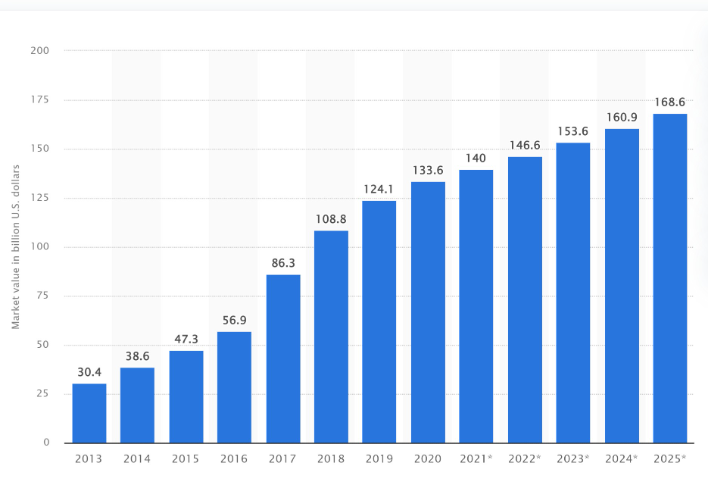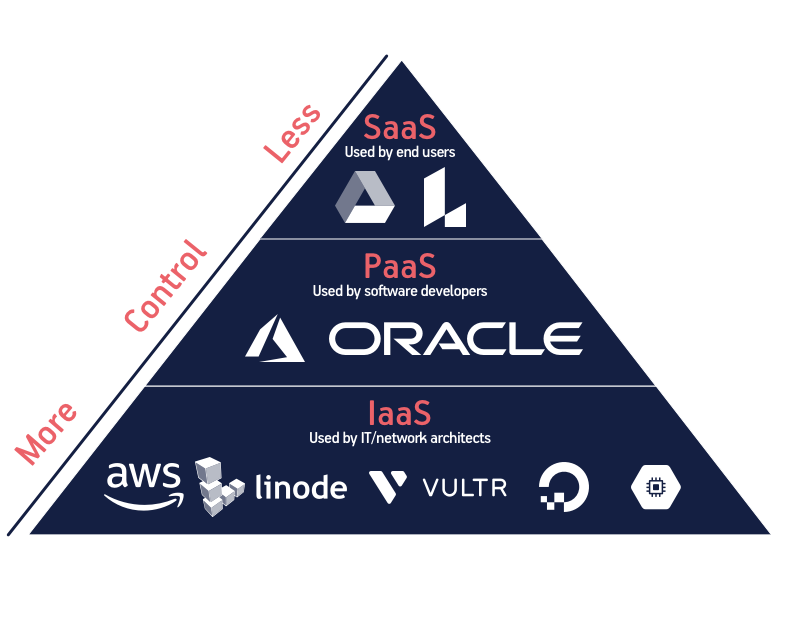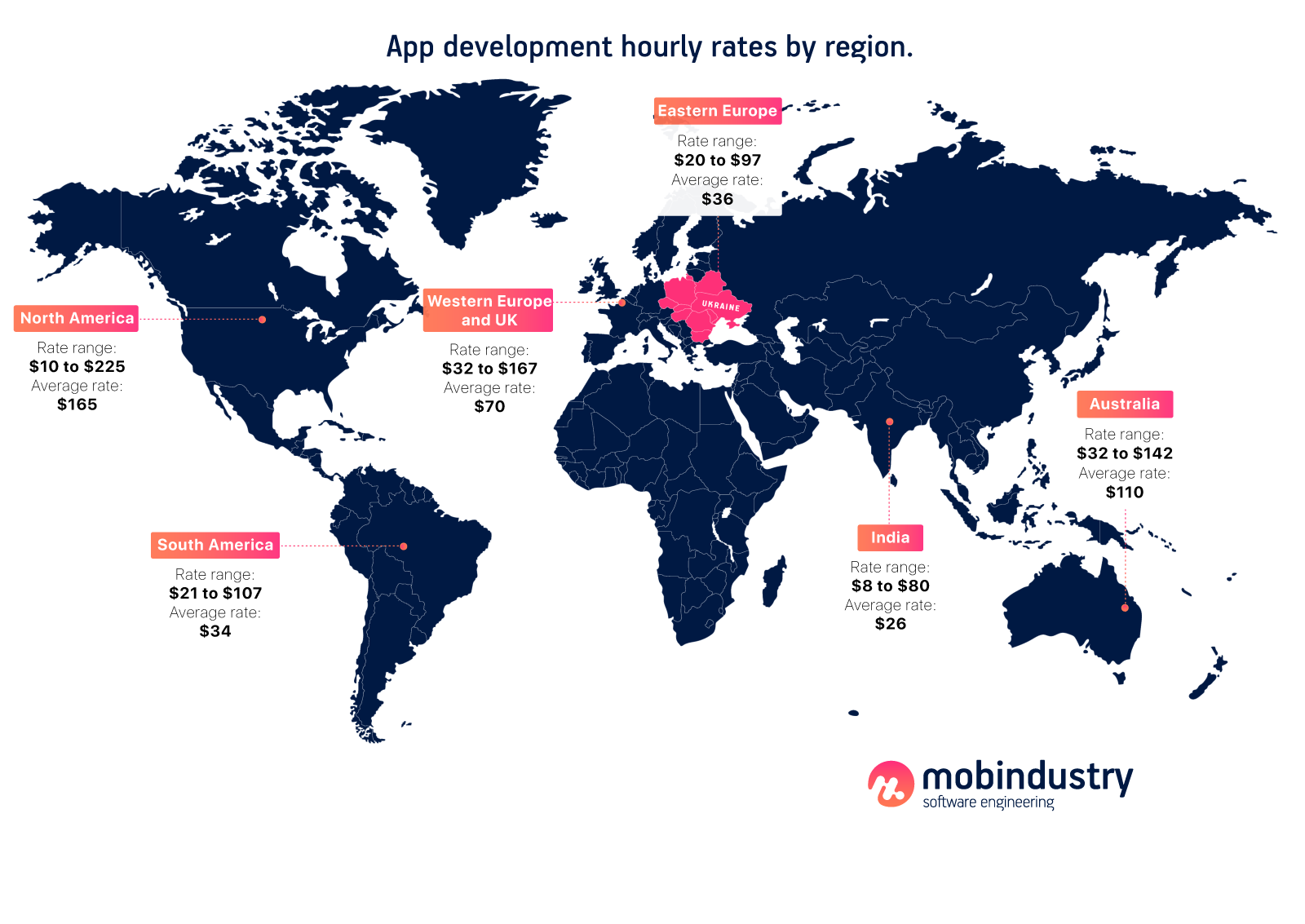Month: October 2022
How to Develop a Cloud-Based Application: An Ultimate Guide
What is a cloud-based app?
A cloud-based application is a software application that is deployed in a cloud environment.
Every application has a user interface (the part the user sees and interacts with) and a back end (the part that processes data and makes the app’s functions work).
In common mobile applications, data and business logic are processed by a smartphone and a computer processor. In cloud applications, these tasks are performed by a remote server. Cloud application development is beneficial because most of the data storage is located on a remote server.
Cloud app market overview
The market for cloud-based applications is growing rapidly. According to Statista, in 2020 this market was worth $133 billion, and by 2025 it’s projected to grow to $168 billion.

The main drivers of this market are the increased demand for mobility in data usage and management, cost-efficiency for the IT infrastructure, and the need to access data from multiple devices and from any location. Cloud-based apps offer mobility, accessibility, scalability, and reduced costs, so it’s an obvious choice for so many businesses.
Previously, large enterprises were the main drivers of the cloud-based app industry, but now the market is growing mainly due to small and medium-sized enterprises interested in shifting to cloud app development.
Cloud-based apps are currently the most popular in the following industries:
- education
- fintech and banking
- insurance
- telecommunication and IT
- government
- healthcare and life sciences
- media and entertainment
- oil and gas
Healthcare is expected to be one of the largest consumers of cloud-based technology because of the growing requirements for data safety and transparency in this sector. Telecommunication is another driving industry, as it requires sharing data with a large number of people.
Benefits of using cloud-based solutions
Cost reduction
With cloud-based technology, you can forget about costly purchases of equipment like servers. Cloud-based apps pay a relatively small fee to a cloud provider, who will handle the equipment, its maintenance, and support. With cloud computing, you don’t need to invest in your own data centers, staff and facilities.
Scalability and unlimited capacity
All you need to do to scale your cloud storage is to just order more space from your cloud provider. You don’t need to buy another server and pay for expanding your infrastructure. You can decrease or increase your storage at any time depending on what your business currently requires, without worrying about how to get a new server or get rid of an old one.
Another great thing about cloud computing is that there’s really no limit to how much data you can store.
Mobility
Cloud computing allows you, your staff, and your customers to access data from any device and from any location as long as they have an internet connection. The data can be accessed, updated, retrieved, and deleted from anywhere.
Data coherency, recovery, and security
With could computing, you’ll always have the same data on your server and on all the clients, meaning that the data is synched across all parts of your infrastructure. It also makes it easy to recover data even if your local storage is damaged.
Cloud computing prevents data loss and makes storing data securely, as cloud providers now offer lots of features like granular permissions and access management.
Characteristics of cloud-based apps
- Application data is stored in cloud infrastructure, so there are minimal device requirements to run cloud applications.
- You can store data locally so an application can work offline. As soon as the device is back online, the app will automatically sync with the cloud.
- Customers can use a cloud-based app from any internet-connected device such as a smartphone, tablet, or laptop. All information is stored in the cloud, so users can pick up where they left off on any device.
There are three types of cloud-based apps: SaaS, IaaS, and PaaS. Let’s figure out what each of them stands for.
Types of cloud-based apps

Let’s see the three types of cloud applications.
Software as a Service (SaaS)
A cloud-based SaaS solution can be used through mobile apps and web browsers. The SaaS model allows customers to use an application without installing and configuring it. With the internet, you can use SaaS solutions around the world from any device.
Companies tend to use SaaS office software like G Suite and messengers like Slack. However, many people also use services like Dropbox for personal use.
Platform as a Service (PaaS)
PaaS solutions offer everything necessary for application development. PaaS relies on a cloud service provider for development tools, infrastructure, and operating systems. PaaS vendors provide software and hardware tools to simplify the development process.
PaaS solutions can include:
- Development tools
- Middleware
- Operating systems
- Database management tools
- Infrastructure
Windows Azure, Heroku, and OpenShift are a few examples of services that use the PaaS cloud computing model.
Get an example of the Discovery Phase documentation for your digital project
Infrastructure as a Service (IaaS)
With a IaaS solution, a service provider manages your business’s infrastructure — servers, network, and storage — through a public or private cloud.
Business owners can access IaaS infrastructure with an API or admin panel.
With the IaaS model, you can manage operating systems and applications while vendors such as AWS, Microsoft Azure, and DigitalOcean provide you with hardware, networks, hard drives, storage, and servers.
Cloud app development: Key differences
What about the specifics of developing cloud applications?
- Creating cloud applications requires deep interaction between programmers, data architects, designers, and quality assurance managers. Developers need to be familiar with various cloud platforms such as Amazon Web Services (AWS), Microsoft Azure, Force.com, and Apache CloudStack. In addition, they should consider connectivity with APIs (application programming interfaces) and CDNs (content delivery networks).
- Your development team must consider that your final solution should be scalable. One of the important reasons why companies choose to store their data in the cloud is that cloud storage is easy to expand, even within a short period of time.
- Cloud applications can be technically unlimited in size, but cloud hosting isn’t free. Concentrating user requests and optimizing data size should be top development priorities.
- To convince people to use your application, you need to ensure their data is stored securely, which isn’t always easy since you’re dealing with cloud technologies that don’t have a single data store. This is why an app’s codebase should be kept separate from other data.
Cloud-based application development step by step
Developing cloud apps is different from developing a web or mobile application. A mobile app development team builds a cloud solution by relying on your chosen service provider. Amazon Web Services (AWS) is probably the best and most reliable solution on the market right now. It offers a number of great tools and features for developing cloud applications.
You should be willing to invest time and money in creating any digital product. Cloud solutions are no exception. Before you start development, you need to understand the problems your app users face and find a way to solve them using your product.
Step #1. Research your app’s target market
When developing a cloud-based mobile app, the first thing you need to consider is the target audience. Understanding your users’ needs makes development easier and leads to a better final product. Find out as much as you can about your potential users. You can start by researching the following:
- Demographics. Find out the average age of your users, where they live, what devices they use, etc.
- Behavioral trends. Find out what decreases a user’s desire to download an app, your users’ security expectations, and so on.
To develop an amazing mobile application, we suggest creating a user persona, or a detailed portrait of your ideal user.
Step #2. Hire a development team
The second step is to find a development team you want to work with. The first phase of development will include business analysis, developing a technical specification, estimating the development cost, and planning the project.
Before diving into the actual development of your mobile app, you and your team should create an app development workflow, choose the main features for the app, and design an app concept. Then your development team should create project milestones and start working on the MVP.
Step #3. Consider the architecture and features
For your application to be successful, you need to carefully consider the architecture and service model. These decisions affect your application’s performance, so it’s best to consult with specialists who can advise you.
Architecture
It’s a good idea to create an advanced data architecture. Classic solutions are always reliable. However, for cloud applications, a microservices architecture is commonly used.
Service model
The service model you select — SaaS, PaaS, IaaS — must match the type of cloud solution you’re developing. For example, when developing an application like Slack, you need to take a SaaS approach.
Step #4. Define the tech stack
When choosing tools for developing cloud applications, you should consult with experts. They’ll analyze your requirements, features, and designs to select the right set of technologies for your product.
Also, be mindful of your application’s scalability to keep your solution up to date.
Here’s a possible tech stack for a cloud-based application:
Application and data
- Akamai
- Cloudant
- ClearDB
Utilities
- Google Analytics
- Twilio
- Optimizely
- Heap
- Recurly
- Zuora
- Cyfe
- TransmogrifAI
DevOps
- Jenkins
- Bitbucket
- New Relic
- Datadog
- Puppet Labs
- Cloud9 IDE
- Sauce Labs
- StillAlive
Business tools
- Jira
- G Suite
- InVision
- Salesforce Sales Cloud
- Balsamiq
- DocuSign
- UXPin
Step #5. Choose a monetization model
The next step is to choose the right monetization model for your mobile application. Now that you know your users’ needs, you can predict what your users will pay for. Here are three monetization models to choose from:
- Paid. This monetization model is quite straightforward: users pay once to access your app.
- Freemium. With this model, users can download your app for free. They can then pay to upgrade their accounts or use premium features.
- In-app purchases. With in-app purchases, users can pay for different items, features, or content inside the app.
- Advertising. You can choose one of the following ad options:
- Cost per click. Charge advertisers every time a user interacts with their ads in your app.
- Cost per mille. Charge advertisers for every 1,000 ad impressions in your app.
- Cost per action. Charge advertisers only when users complete a target action, such as installing an app or signing up for a newsletter.
Step #6. Create an MVP
Creating a cloud-based app is a big and complex project. We recommend launching a minimum viable product (MVP) first and testing its technical and business performance. By using an MVP approach, you’ll be able to find out what users like and don’t like in your app. Then you’ll be able to consider their feedback and improve your app.
Step #7. Test your product carefully
Cloud-based app development should include a testing stage. Before launching your product, your development team has to test it to find any bugs.
At this point, you’ll verify that your application is working correctly and provides a satisfying user experience. To do this, it’s best to cooperate with a full-cycle development company.
Full-cycle development companies offer development, design, testing, and management services. With one team working on your project from start to finish, communication is vastly simplified. This results in higher product quality.
Step #8. Launch the app and keep it up to date
You can release your app on the App Store (iOS) and Google Play (Android). Google Play uses automated testing to speed up the app store approval process. However, if your application is rejected by Google, it can be difficult to find out why.
The App Store delegates app validation to real people. If validators don’t approve your app, they’ll ask you to make specific changes.
If you want to distribute your app exclusively within your organization via the App Store, you’ll need to pay $299 a year to join the Apple Developer Enterprise Program. Google Play doesn’t charge for its analogous service.
Here’s a list of information you need to prepare before submitting your application.
For Google Play:
- Screenshots
- App name
- Description keywords
- Support URL
- Marketing URL
- Privacy policy URL
- App icon
- Categories
- Rating
- Copyright
- Demo account
- Version information
- Pricing information
For the App Store:
- Title (app name)
- Short description
- Full description
- Screenshots
- High-resolution icon
- Featured graphic
- Promo video (optional)
- Type and category
- Content rating
- Languages and translations (if any)
- Contact details
- Privacy policy
- Compatible devices
- Pricing and distribution
Some of the materials listed will cost you nothing to produce, while others will be quite expensive. Creating a copyright and privacy policy usually takes time and expensive legal services. How much does it cost to list an app on the App Store and Google Play if a development company helps you? Releasing an application can take different amounts of time depending on the amount of work the company has to do.
Also, remember that before your app is published on either app store, it must go through an approval process. This procedure can take some time and require additional development costs. If your app doesn’t meet platform rules or requirements, it won’t be accepted.
If your app isn’t accepted, you may need to make a few changes in order to get it approved. Some mobile app development companies provide their services until your app gets approved, but others don’t.
How much does it cost to build a cloud-based app?
The cost of developing a cloud-based mobile app depends on these factors:
- Product features
- Product design
- Hourly rate of your development team
- Project size and complexity
- Technology stack
- Number of team members on the project
- Time frame
The biggest factor that influences a project’s cost is the hourly rate of developers, and that often depends on their location. For example, an application that costs $40,000 to build in the US will cost around $9,000 if developed by engineers in Ukraine.

Building your cloud application with a company based in Eastern Europe is cost-effective and gives you access to top talent.
Quick summary of developing a cloud-based app
Developing a cloud-based app is hard and time-consuming. But if done correctly, your app can become successful and bring a lot of value to users.
Key takeaways:
- A cloud-based application is a software application that is deployed in a cloud environment.
- Your development team should consider that the final solution must be scalable. One important reason why companies choose to store their data in the cloud is that cloud storage is easy to expand, even within a short period of time.
- Cloud applications can be technically unlimited in size, but cloud hosting isn’t free. Concentrating user requests and optimizing data size should be top development priorities.
- When developing a mobile app, the first thing you need to consider is your target audience.
- Choose the right monetization model for your mobile application: free, paid, freemium, or ad-based.
- Find a development team to work with. The first phase of development will include business analysis, creating a technical specification, estimating the development cost, and planning the project.
- We recommend launching a minimum viable product (MVP) first and testing its technical and business performance.
If you want to create a cloud-based app but don’t know where to start, contact Mobindustry for a free consultation.


